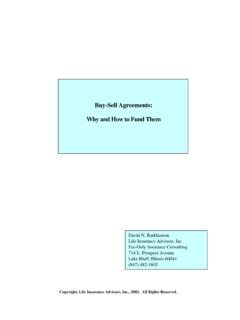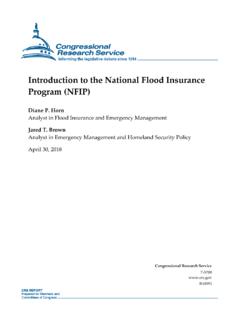Transcription of Universal Life with No Lapse Guarantees: What You …
1 life INSURANCE ADVISORS, INC. FEE-ONLY INSURANCE CONSULTING. 714 E. PROSPECT AVENUE LAKE BLUFF, ILLINOIS 60044. PHONE (847) 482-1605 FAX (847) 234-9973. Universal life with No Lapse Guarantees: What You Need to Know! by David N. Barkhausen Guaranteed death benefit permanent life insurance now sells at prices well below the guarantees of the past. It takes the form of Universal life policies sold with secondary or no Lapse guarantees. Universal life policies will normally expire ( Lapse ) if the cash or account value dwindles to the point that it is insufficient to cover a policy's ongoing charges for insurance and expense costs.
2 With the no- Lapse feature or secondary guarantee, the policies promise to stay in effect for the guaranteed period (usually the insured's life ) if the premium is paid regularly and on time, even if the cash value has run out. Long-term secondary guaranteed policies first appeared in the marketplace about a decade ago. But over the past few years, companies have incorporated more and more aggressive pricing to generate lower and lower premiums. Today, the low premiums required for these guarantees have made these policies the hottest commodities in the life insurance industry.
3 Not only are they grabbing a large market share of new permanent insurance; they are replacing many existing policies whose current non-guaranteed projections simply cannot match the guaranteed death benefits of the lowest priced versions of this new product. The appeal of these competitive guarantees is understandable. The burst of the 1990's stock market bubble and a steady decline in interest rates have lowered investors' near-term expectations and increased the allure of investment guarantees generally. For those who are considered preferred risks, these policies commonly guarantee internal rates of return on premiums paid of 7 percent or more at age 80, 6 percent at age 90 and 5 percent at age 100 and all income tax-free because of the favorable tax treatment of policy death benefits.
4 At a time of low interest rates at least, what fixed income investment could hope to do better? Is it any wonder that agents have found many receptive prospects for this product? Traditional Policy Guarantees and Pricing: Historically, life insurance policy guarantees and their pricing have been very conservative. They have been based on interest rates well below the investment returns of many insurance company portfolios (generally around 4 percent) and mortality and expense charges much higher than those actually experienced (a 1980 mortality table for the general population, for example).
5 With such conservative assumptions, the required premium for a certain guaranteed death benefit with traditional products has been relatively high. It is often about twice the much lower premium cost for the same death benefit assuming the indefinite continuation of a carrier's current non-guaranteed performance. Because of the very conservative nature of traditional life insurance policy guarantees, the comparative guaranteed values of permanent life insurance illustrations have generally been an inappropriate and misleading basis for evaluating competing companies and products.
6 Current Copyright, life Insurance Advisors, Inc., 2004. All Rights Reserved. -2- performance, if honestly calculated and projected, is a fairer method of comparison, even though it is certain that future performance will differ from current projections, either up or down, because of changes in investment results and other policy factors. Guaranteed death benefits at bargain prices come on the heels of disappointment and frustration with the non-guaranteed performance of traditional products. For traditional policies purchased over the past 15 or 20 years, their actual non-guaranteed performance has badly lagged the projections made when the policies were sold.
7 The steep fall in interest rates over this period, sometimes coupled with increased mortality charges, has had, or will have, serious and sometimes fatal consequences for these policies. Policyholders who had assumed, based on a policy sales illustration, that they would only have to pay premiums for a certain number of years are still paying them, or vanished premiums are reappearing. More often, those who attempted to purchase the most permanent death benefit for the lowest possible premium face the likelihood that, without significant premium increases, all or much of their coverage will vanish before they do.
8 The policies will shrink or disappear altogether not because of an insurer's financial problems but because they are insufficiently funded in light of their actual performance. It is important to understand that some policies have performed well in light of these trends, especially in comparison to the returns from similar policies or comparable investments. Yet, even these policies, if designed to provide the most death benefit for the least premium or to limit premium outlays to a certain period of years, may have proven disappointing in the manner just described.
9 The No- Lapse Guarantee Difference: In light of this recent experience, the market for no Lapse guaranteed Universal life with aggressively low-priced premiums has been especially ripe. Guaranteed premiums on these products are generally less than half the premiums required to guarantee the same death benefits from traditional products. Even more compelling, the premiums on these guaranteed policies are often less than the non-guaranteed premium needed to fund the same death benefit in the most competitive traditional product based on a projection of current performance.
10 The no- Lapse policies have little, and possibly no, cash value, in comparison to high cash values in the best traditional whole life policies. By their nature, whole life policies have cash values that grow to equal the death benefit at the age of endowment (usually, age 100). The ability of companies issuing no- Lapse Universal life to avoid paying competitive cash surrender values ( , the cumulative investment of premiums less reasonable insurance charges and expenses, including sales loads) to policyholders who terminate their policies is an extra source of profit that these companies can use to pay competitive guaranteed death benefits.






